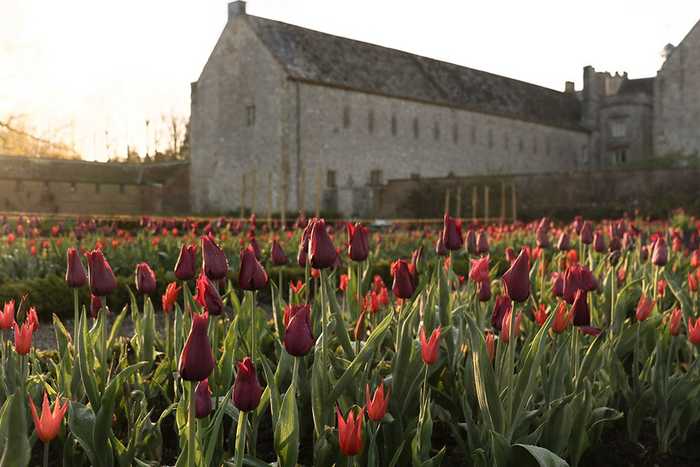Perennial Tulips For A Longer Lasting Display

Velvety reds and purples under a canopy of acid green, and oranges, and whites intermingling with pinks. After the pared back minimalism of the Winter scape, a Spring catwalk of tulips and an exuberant flush of colour will be choreographed by Joshua Sparkes, our head gardener.
Keen to evolve the annual display of tulips and with a mind to sustainability, Josh has created a design for 2019 that allows the tulips to have more of a perennial nature. The annual style of planting is big on impact but to create a more natural style of planting, it’ll be a 70/30 mix of perennials and annuals, with the opportunity to edit the mix each year and evolve a more complex and layered landscape. By putting new perennial bulbs into the mix every three or so years, the aim is to create more varied clumps, combining a flush of big vigorous bulbs in their first year, shorter ones in their second and again, a different form in their third year. A combination of different heights and colour fade with age alongside newer ones with added zing for variety and interest.
With a perennial scheme in mind (or ‘short lived’ perennial at least by definition of the word perennial), you’ll need a variety that hasn’t been bred too much, as over breeding makes them more annual and inhibits their life in the soil; Appeldorn, Negrita, Paul Scherer and Ballerina will be our test varieties going in this year, coaxed into deeper pockets to avoid the wrath of the fork. Threes times the depth of the bulb is the perceived wisdom, but you can also gauge it on the depth of the trowel so when you’re working the borders you won’t be jabbing at the tulips left, right and centre.
For an all year round aesthetic, Josh will be creating ‘rivers’ of tulips and biennials that will flow through the borders, pockets designed to coexist with established perennials with the opportunity to add further interest later in the year.As in nature, the early spring bulbs will grow up and through the emerging foliage of the Summer perennials, hiding any straggly unsightliness and covering up what’s gone before, a successional planting scheme with interest from Spring all the way through to Summer.
To map out a designated area for tulips in the design, Josh uses pea sticks of varying lengths, marking out a grid reference for what’s where in the beds, which he’ll leave in place until February. It’s a tried and tested formula, as however much you think you’ll remember where everything is, the chances are you won’t and as with all guesswork, there are always varying degrees of success.
Added to the mix will be a variety of Spring bulbs including,scilla, chinadoxia, anemones, fritillaria persica, narcissus Thalia, and drawf Minnow. To be combined with hesperis and honesty, and purple kale, something to look forward to after the long and dark days of Winter.
We’ll be posting updates as we go, so do follow the team on instagram and watch their story unfold.
Posted on November 12th 2018

